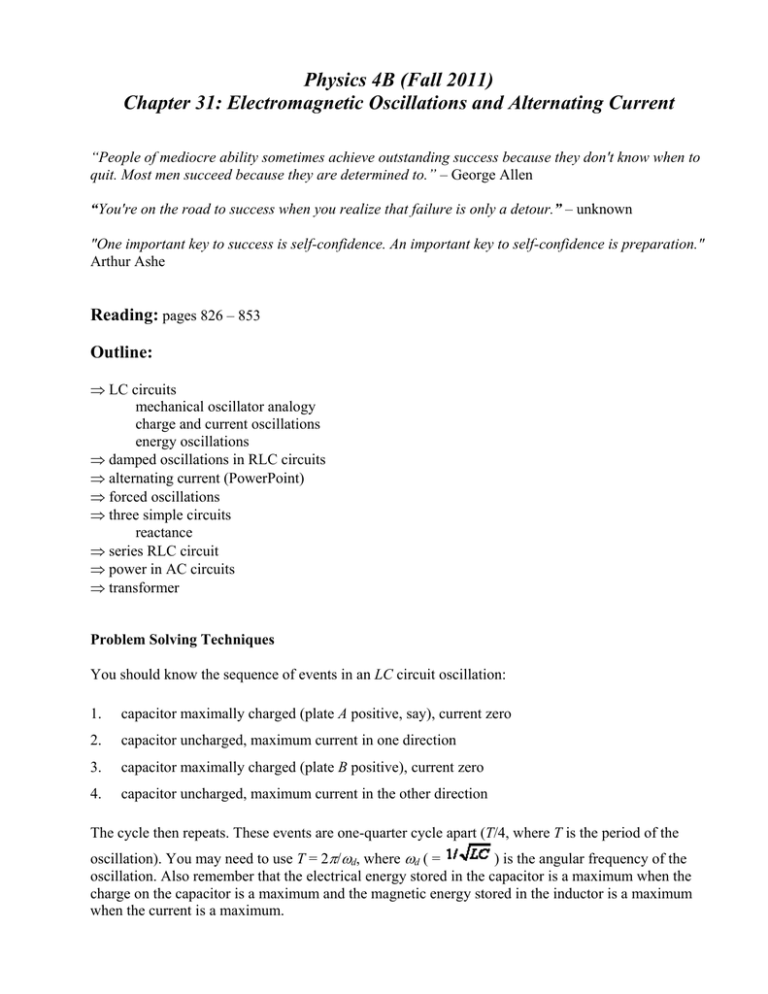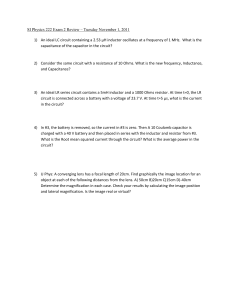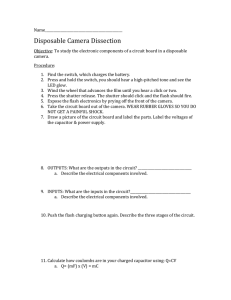Physics 4B (Fall 2011) Chapter 31: Electromagnetic Oscillations and Alternating Current
advertisement

Physics 4B (Fall 2011) Chapter 31: Electromagnetic Oscillations and Alternating Current “People of mediocre ability sometimes achieve outstanding success because they don't know when to quit. Most men succeed because they are determined to.” – George Allen “You're on the road to success when you realize that failure is only a detour.” – unknown "One important key to success is self-confidence. An important key to self-confidence is preparation." Arthur Ashe Reading: pages 826 – 853 Outline: ⇒ LC circuits mechanical oscillator analogy charge and current oscillations energy oscillations ⇒ damped oscillations in RLC circuits ⇒ alternating current (PowerPoint) ⇒ forced oscillations ⇒ three simple circuits reactance ⇒ series RLC circuit ⇒ power in AC circuits ⇒ transformer Problem Solving Techniques You should know the sequence of events in an LC circuit oscillation: 1. capacitor maximally charged (plate A positive, say), current zero 2. capacitor uncharged, maximum current in one direction 3. capacitor maximally charged (plate B positive), current zero 4. capacitor uncharged, maximum current in the other direction The cycle then repeats. These events are one-quarter cycle apart (T/4, where T is the period of the oscillation). You may need to use T = 2π/ωd, where ωd ( = ) is the angular frequency of the oscillation. Also remember that the electrical energy stored in the capacitor is a maximum when the charge on the capacitor is a maximum and the magnetic energy stored in the inductor is a maximum when the current is a maximum. Some problems deal with the analogy between an LC electrical circuit and a block-spring mechanical system. Remember that q x, L m, C 1/k, and i v. You should know the relationship between the maximum charge on the capacitor and the maximum current: I = ωdQ. You should also know that the total energy of the circuit can be written in terms of either of these: U = Q2/2C = LI2/2. Some problems ask you to compute the maximum charge on the capacitor, given the maximum potential difference across the plates: Q = CVmax. Some problems deal with damped circuits. You should know that the frequency of oscillation changes with the addition of resistance and that in succeeding cycles, the maximum charge on the capacitor decreases exponentially, the relevant factor being e-Rt/2L. You should know how to calculate the reactances and the impedance for an RLC series circuit: XL = ωdL, XC = 1/ωdC, and , where ωd is the angular frequency. Some problems give the frequency fd and you must use ωd = 2πfd. You should know how to compute the current given the generator emf. If = m sin ωdt, then i = I sin(ωdt - φ), where I = m/Z and tan φ = (XL - XC)/R. Think of φ as a phase difference. That is, if = m sin(ωdt + α), then i = I sin(ωdt + α - φ). Given the current, you should know how to compute the potential differences across the individual circuit elements: vR = iR, vC = IXC sin(ωdt - π/2), and vL = IXL sin(ωdt + π/2). Finally, you should know that the generator supplies energy at the rate P = i , the inductor stores energy at the rate PL = ivL, the capacitor stores energy at the rate PC = ivC, and the resistor generates thermal energy at the rate PR = i2R. These are all time dependent quantities. Sometimes the rms values of current and potential differences are given or requested. You should remember that if i = I sin(ωdt - φ), then irms = I/ . Similar expressions hold for the potential differences. You should also recognize that equations such as vL = IXL sin(ωdt + π/2) lead to VL rms = irmsXL. Questions and Example Problems from Chapter 31 Question 1 For each of the curves of q(t) in the figure below for an LC circuit, determine the least positive phase constant Φ in the equation q = Q cos(ω t + Φ ) required to produce the curve. Question 2 The figure below shows three oscillating LC circuits with identical inductors and capacitors. Rank the circuits according to the time taken to fully discharge the capacitors during the oscillations, greatest first. Question 3 The figure below shows the current i and driving emf ε for a series RLC circuit. (a) Does the current lead or lag the emf? (b) Is the circuit's load mainly capacitive or mainly inductive? (c) Is the angular frequency ωd of the emf greater than or less than the natural angular frequency ω? Question 4 The figure above (Question 3) shows the current i and driving emf ε for a series RLC circuit. Relative to the emf curve, does the current curve shift leftward or rightward and does the amplitude of that curve increase or decrease if we slightly increase (a) L, (b) C, and (c) ωd? Problem 1 In an oscillating LC circuit, L = 1.10 mH and C = 4.00 μF. The maximum charge on the capacitor is 3.00 μC. Find the maximum current. Problem 2) An oscillating LC circuit consisting of a 1.0 nF capacitor and a 3.0 mH coil has a maximum voltage of 3.0 V. What are (a) the maximum charge on the capacitor, (b) the maximum current through the circuit, and (c) the maximum energy stored in the magnetic field of the coil? Problem 3 In an oscillating LC circuit with C = 64.0 μF, the current as a function of time is given by i = (1.60) sin(2500t + 0.680), where t is in seconds, i in amperes, and the phase constant in radians. (a) How soon after t = 0 will the current reach its maximum value? What are (b) the inductance L and (c) the total energy? Problem 4 What resistance R should be connected in series with an inductance L = 220 mH and capacitance C = 12.0 μF for the maximum charge on the capacitor to decay to 99.0% of its initial value in 50.0 cycles? (Assume ω´ ≈ ω.) Problem 5 (a) At what frequency would a 6.0 mH inductor and a 10 μF capacitor have the same reactance? (b) What would the reactance be? (c) Show that this frequency would be the natural frequency of an oscillating circuit with the same L and C. Problem 6 An ac generator has emf ε = εm sin(ωdt - π/4), where εm = 30.0 V and ωd = 350 rad/s. The current produced in a connected circuit is i(t) = I sin(ωdt - 3π/4), where I = 620 mA. At what time after t = 0 does (a) the generator emf first reach a maximum and (b) the current first reach a maximum? (c) The circuit contains a single element other than the generator. Is it a capacitor, an inductor, or a resistor? Justify your answer. (d) What is the value of the capacitance, inductance, or resistance, as the case may be? Problem 7 Remove the inductor from the circuit in the figure below and set R = 200 Ω, C = 15.0 μF, fd = 60.0 Hz, and m = 36.0 V. What are (a) Z, (b) φ and (c) I? (d) Draw a phasor diagram. Problem 8 (a) In an RLC circuit, can the amplitude of the voltage across an inductor be greater than the amplitude of the generator emf? (b) Consider an RLC circuit with εm = 10 V, R = 10 Ω, L = 1.0 H, and C = 1.0 μF. Find the amplitude of the voltage across the inductor at resonance. Problem 9 A coil of inductance 88 mH and unknown resistance and a 0.94 μF capacitor are connected in series with an alternating emf of frequency 930 Hz. If the phase constant between the applied voltage and the current is 75°, what is the resistance of the coil? Problem 10 (a) Show that the average rate at which energy is supplied to the circuit of Fig. 33-7 can also be written as Pavg = ε2rmsR/Z2. Then show that this expression for average power gives reasonable results for (b) a purely resistive circuit, (c) an RLC circuit at resonance, (d) a purely capacitive circuit, and (e) a purely inductive circuit. Problem 11 The figure below shows an ac generator connected to a “black box” through a pair of terminals. The box contains an RLC circuit, possibly even a multiloop circuit, whose elements and connections we do not know. Measurements outside the box reveal that and (a) What is the power factor? (b) Does the current lead or lag the emf? (c) Is the circuit in the box largely inductive or largely capacitive? (d) Is the circuit in the box in resonance? (e) Must there be a capacitor in the box? (f) An inductor? (g) A resistor? (h) At what average rate is energy delivered to the box by the generator? (i) Why don't you need to know the angular frequency wd to answer all these questions? Problem 12 In an RLC circuit such as that of the figure below, assume that R = 5.00 Ω, L = 60.0 mH, fd = 60.0 Hz, and εm = 30.0 V. For what values of the capacitance would the average rate at which energy is dissipated in the resistance be (a) a maximum and (b) a minimum? What are (c) the maximum dissipation rate and the corresponding (d) phase angle and (e) power factor? What are (f) the maximum dissipation rate and the corresponding (g) phase angle and (h) power factor? Problem 13 A generator supplies 100 V to the primary coil of a transformer of 50 turns. If the secondary coil has 500 turns, what is the secondary voltage?

![Sample_hold[1]](http://s2.studylib.net/store/data/005360237_1-66a09447be9ffd6ace4f3f67c2fef5c7-300x300.png)




